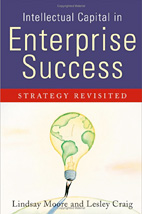The theory and practice of professional strategy is reaching into the world of philanthropic and nonprofit organizations and driving the creation of new strategic performance measurement systems that promise to optimize the delivery of social and cultural benefit to society.
Advanced Strategic Thinking
Strategic thinking involves all the topics of strategic planning and the highest thinking about a company or an enterprise, who it is, where it is going, for what purpose, to what end. In particular, strategic thinking in concerned with the development of "competitive strategy" and the development of a sustainable competitive advantage in the marketplace.
New Thinking About the Value of Strategy
During the 1960s and the 1970s, “strategic planning” emerged as the model for corporate planning. However, by the 1980s, the value of strategic planning began to be called into question.
Competitive Strategy
Competitive advantage is that toward which strategic thinking aspires. Yet, ultimately, all competitive advantages are transitory. The only “sustainable competitive advantage” is the commitment to keep evolving one’s strategy to stay current with the times.
The Capitalist Business Model – Efficiency and Innovation
Much of the present debate over outsourcing is driven by focusing only on a portion of the entire capitalist business model … greater profitability leads to enhanced innovation, training, and education which drive the creation of higher paying new jobs, which drive the next wave of economic growth. Economically our faith has to be with capitalism, and politically our commitment has to be with the engines of innovation and education that allow workers to move up the ladder.
Strategic Readiness
The competitive advantages found in modern corporations, non-profit organizations, and even governmental agencies are increasingly determined by the strategic readiness of their intangible assets. Typically, an organization’s physical assets, such as machinery, finished goods inventory, or cash are immediately deployable in most situations. However, intangible assets present new challenges in terms of how responsively they can be deployed for business purposes.

 As the knowledge-based economy expands, the companies and individuals that possess intangible intellectual assets, such as intellectual property, will need specialized expertise, strategic thinking, legal experience, and the wisdom necessary to manage intellectual assets.
As the knowledge-based economy expands, the companies and individuals that possess intangible intellectual assets, such as intellectual property, will need specialized expertise, strategic thinking, legal experience, and the wisdom necessary to manage intellectual assets.